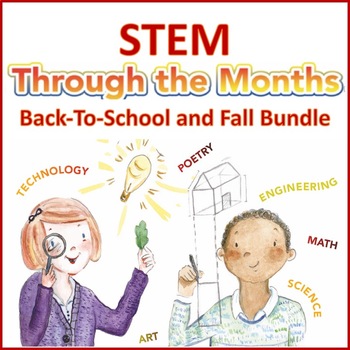STEM Through the Months: Back to School and Fall Bundle
- PDF
Description
Thematic STEM/STEAM lessons and projects for Back-to-School (August), September, October and November. This 265 page edition also includes STEM/STEAM journals that you can use throughout the year.
Individually, September, October, and November are $5.95 each. Also included is the $10.95 Back To School with STEM/STEAM Journals. This bundle at $21.95 is a very sweet Back-To-School deal.
Designed for teachers and students, these activities help you make and create wonderful classroom experiences. Using monthly-themed events as a springboard and the maker movement for inspiration, students build cross-curricular connections as they explore STEM - Science, Technology, Engineering and Math.
Primarily aimed for students in grades three through eight, these engaging and innovative lessons and projects are easily adopted and adapted for learners of all ages. The projects and poetry lessons have been classroom-tested and provide enjoyable learning experiences in a variety of learning environments: home schooling; after-school programs; scouting; gifted and talented programs; extra-curricular clubs; adult ESL classes; and senior citizen activities.
Inside this bundle you will find four months of jam-packed STEM lessons, projects and poetry to be used for August through November and all throughout the year. Drawing on the inner poet in every child and the “let me do-it-myself” nature inherent in all learners, the activities and lessons will help your students earn an A for the Arts and will bring STEAM to your STEM initiatives. Your budding scientists, mathematicians and engineers practice creative and inventive thinking skills as they develop throughout the year.
These materials focus on science, technology, engineering, the arts and mathematics. You and your students will especially love the core poetry lessons. Students love poetry and learning about famous poets and their poems integrate easily with your STEM and common core focus. From our teaching experience, we have learned that some teachers are uncomfortable introducing how to write poetry. You will be amazed how easily these classroom-tested activities will assist young poets discover the joy of writing their own poetry.
We hope that you have access to some classroom or school technology. As technology using educators, we know that technology enriches the classroom experience. For over thirty years, students and teachers have used technology tools to add exciting dimensions and high interest to classroom work. We have specifically designed these activities and projects to be enriched through the use of technology, however it is not a pre-requisite. Paper, pencils and other common classroom supplies will suffice. If you have access to a few computers and a printer, great, we believe strongly in using what you have. There is no need to go out and buy the latest and greatest.





